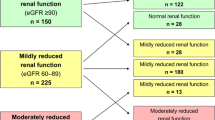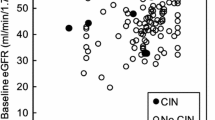Abstract
An iodinated contrast medium (CM) is generally excreted into the urinary tract within 3 min after administration. However, some cases present a persistent kidney nephrogram several hours after administration of CM. This phenomenon seems to be associated with the development and acceleration of contrast-induced nephropathy (CIN). A 74-year-old woman with chronic kidney disease and a very low ejection fraction (EF) (11%) was admitted to Sapporo Medical University Hospital because of heart failure. Coronary angiography revealed occlusion of the left anterior descending artery (LAD) on day 21 of admission. Percutaneous coronary intervention (PCI) to the LAD using 218 ml of iohexol was performed with a preventive measure for CIN by saline infusion on day 28. After PCI, she developed CIN requiring hemodialysis. Non-contrast computed tomography 48 h after PCI showed a marked bilateral persistent nephrogram with a cortical attenuation value of 168 HU. Vicarious excretion of CM was noted in the small bowel and colon. Her kidney function gradually recovered and hemodialysis was discontinued after ten sessions on day 43. The findings from this case suggest that a patient with a very low EF is at a high risk for CIN through persistent retention of the CM in the kidney cortex.





Similar content being viewed by others
References
Mehran R, Owen R, Chiarito M, Baber U, Sartori S, Cao D, Nicolas J, Pivato CA, Nardin M, Krishnan P, Kini A, Sharma S, Pocock S, Dangas GA. A contemporary simple risk score for prediction of contrast-associated acute kidney injury after percutaneous coronary intervention: derivation and validation from an observational registry. Lancet. 2021;398:1974–83.
McCullough PA, Choi JP, Feghali GA, Schussler JM, Stoler RM, Vallabahn RC, Mehta A. Contrast-induced acute kidney injury. J Am Coll Cardiol. 2016;68:1465–73.
Shibata S, Moniwa N, Kuno A, Kimura A, Ohwada W, Sugawara H, Gocho Y, Tanaka M, Yano T, Furuhashi M, Tanno M, Miki T, Miura T. Involvement of necroptosis in contrast-induced nephropathy in a rat CKD model. Clin Exp Nephrol. 2021;25:708–17.
Wolin EA, Hartman DS, Olson JR. Nephrographic and pyelographic analysis of CT urography: principles, patterns, and pathophysiology. AJR Am J Roentgenol. 2013;200:1210–4.
Chou SH, Wang ZJ, Kuo J, Cabarrus M, Fu Y, Aslam R, Yee J, Zimmet JM, Shunk K, Elicker B, Yeh BM. Persistent renal enhancement after intra-arterial versus intravenous iodixanol administration. Eur J Radiol. 2011;80:378–86.
Love L, Johnson MS, Bresler ME, Nelson JE, Olson MC, Flisak ME. The persistent computed tomography nephrogram: its significance in the diagnosis of contrast-associated nephrotoxicity. Br J Radiol. 1994;67:951–7.
McDonald JS, Steckler EM, McDonald RJ, Katzberg RW, Williamson EE, Cernigliaro JG, Hamadah AM, Gharaibeh K, Kallmes DF, Leung N. Bilateral sustained nephrograms after parenteral administration of iodinated contrast material: a potential biomarker for acute kidney injury, dialysis, and mortality. Mayo Clin Proc. 2018;93:867–76.
Ronco C, Haapio M, House AA, Anavekar N, Bellomo R. Cardiorenal syndrome. J Am Coll Cardiol. 2008;52:1527–39.
Ariyoshi S, Tanabe M, Ito K. Evaluation of the renal parenchymal retention of iodinated contrast agent during follow-up computed tomography performed one day after undergoing contrast-enhanced computed tomography. Eur J Radiol. 2020;132: 109335.
Stevens MA, McCullough PA, Tobin KJ, Speck JP, Westveer DC, Guido-Allen DA, Timmis GC, O’neill WW. A prospective randomized trial of prevention measures in patients at high risk for contrast nephropathy: results of the P.R.I.N.C.E. study. Prevention of radiocontrast induced nephropathy clinical evaluation. J Am Coll Cardiol. 1999;33:403–11.
Ben-Haim Y, Chorin E, Hochstadt A, Ingbir M, Arbel Y, Khoury S, Halkin A, Finkelstein A, Banai S, Konigstein M. Forced diuresis with matched isotonic intravenous hydration prevents renal contrast media accumulation. J Clin Med. 2022;11:885.
Briguori C, Visconti G, Focaccio A, Airoldi F, Valgimigli M, Sangiorgi GM, Golia B, Ricciardelli B, Condorelli G. REMEDIAL II investigators. Renal insufficiency after contrast media administration trial II (REMEDIAL II): renalguard system in high-risk patients for contrast-induced acute kidney injury. Circulation. 2011;124:1260–9.
Katzberg RW, Monsky WL, Prionas ND, Sidhar V, Southard J, Carlson J, Boone JM, Lin TC, Li CS. Persistent CT nephrograms following cardiac catheterisation and intervention: initial observations. Insights Imaging. 2012;3:49–60.
Chu LL, Katzberg RW, Solomon R, Southard J, Evans SJ, Li CS, McDonald JS, Payne C, Boone JM, RamachandraRao SP. Clinical significance of persistent global and focal computed tomography nephrograms after cardiac catheterization and their relationships to urinary biomarkers of kidney damage and procedural factors: pilot study. Invest Radiol. 2016;51:797–803.
Chyrchel M, Hałubiec P, Łazarczyk A, Duchnevič O, Okarski M, Gębska M, Surdacki A. Low ejection fraction predisposes to contrast-induced nephropathy after the second step of staged coronary revascularization for acute myocardial infarction: a retrospective observational study. J Clin Med. 2020;9:1812.
Mehran R, Aymong ED, Nikolsky E, Lasic Z, Iakovou I, Fahy M, Mintz GS, Lansky AJ, Moses JW, Stone GW, Leon MB, Dangas G. A simple risk score for prediction of contrast-induced nephropathy after percutaneous coronary intervention: development and initial validation. J Am Coll Cardiol. 2004;44:1393–9.
Author information
Authors and Affiliations
Corresponding author
Ethics declarations
Conflict of interest
The authors have declared that no conflict of interest exists.
Human and animal participation
This article does not contain any studies with human participants or animals performed by any of the authors.
Informed consent
Informed consent was obtained from the patient described.
Additional information
Publisher's Note
Springer Nature remains neutral with regard to jurisdictional claims in published maps and institutional affiliations.
About this article
Cite this article
Moniwa, N., Kimura, A., Nishikawa, R. et al. Marked bilateral global persistent CT nephrogram 48 h after percutaneous coronary intervention with contrast-induced nephropathy requiring transient hemodialysis with severe cardiac dysfunction. CEN Case Rep 12, 1–6 (2023). https://doi.org/10.1007/s13730-022-00713-2
Received:
Accepted:
Published:
Issue Date:
DOI: https://doi.org/10.1007/s13730-022-00713-2




